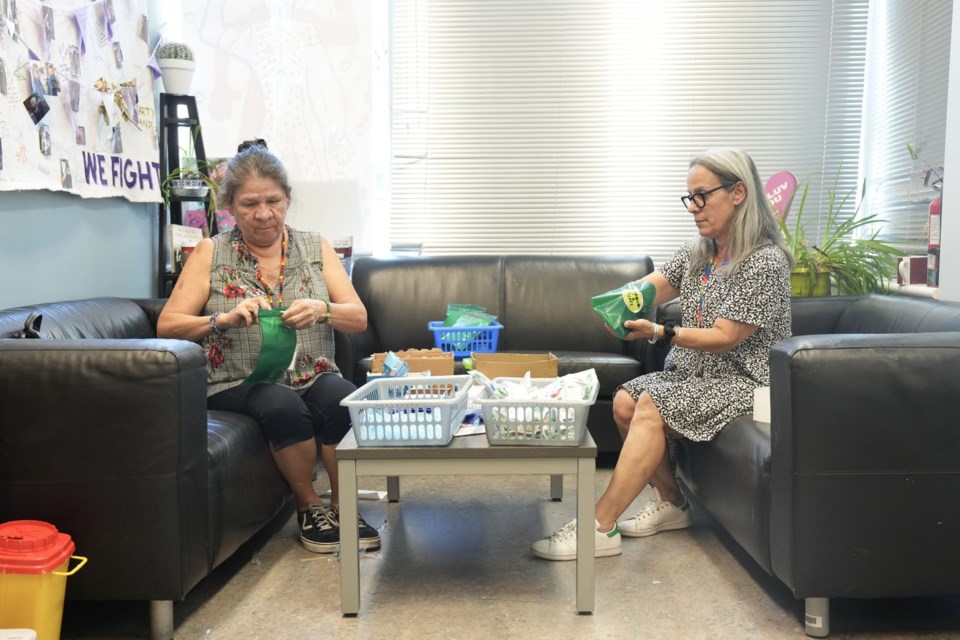TORONTO — Advocates for supervised consumption sites vowed Monday to fight Ontario Premier Doug Ford's decision to shutter 10 of those spots, saying the sites save lives and should be expanded instead.
But the premier argued critics ought to be grateful the province is pouring millions into treatment services while moving away from the supervised consumption model.
The province announced last week that it was fundamentally shifting its policy on the overdose crisis, distancing itself from drug consumption sites, safer supply programs and needle exchange programs to focus on treatment.
Advocates, including health-care workers, took to Queen's Park on Monday to voice their concerns on the change and the devastating effects of the opioid crisis that killed nearly 2,600 people in 2023.
"One of the comprehensive responses to the drug death crisis have been supervised consumption services," said Zoe Dodd of the Toronto Overdose Prevention Society.
"We need to expand them."
The province has said it is closing 10 consumption sites because they were too close to schools and daycares and said new ones would not be allowed to open. It's also planning legislation to prohibit participation in the federal government's safer supply program that sees prescription medication given to people instead of drugs bought off the street.
Health Minister Sylvia Jones said increased crime and concerns from neighbours and parents about problems near those sites drove the province to act.
The government said it will launch 19 new "homelessness and addiction recovery treatment hubs" plus 375 highly supportive housing units at a cost of $378 million.
Ford had a message on Monday for harm reduction advocates.
"I think they should be very grateful," he said at an unrelated news conference.
"We just announced – I think it's $376 million, never been announced before – to make sure we help people out, get detox beds, rehabilitation and getting them back on their feet, making sure we have proper housing for them and job opportunities."
The changes came after the province initiated several reviews of its 17 consumption and treatment service sites following the killing of a bystander near a Toronto site. Karolina Huebner-Makurat had been walking through her neighbourhood shortly after noon on July 7, 2023, when she was shot as a fight broke out between three alleged drug dealers.
Two of those government-commissioned reviews did not recommend closing the consumption sites, but suggested increasing security near them and working better with the community to address concerns.
A third review of all the sites, by Chief Medical Officer of Health Dr. Kieran Moore, was not released to the public.
One problem with the province's plan is that even with expansion of treatment services, detox and treatment beds are in high demand and far too few in number, said Lorraine Lam, an outreach worker in downtown Toronto.
"They are handing out death sentences but disguising them as care for people who are using substances, disguising them as treatment facilities and disguising them through an insulting number of supportive housing beds," she said.
"375 beds? In Toronto, there are 10,000 people sleeping in shelters."
Lam said there are many barriers to entering a treatment program as rehabilitation facilities usually require patients to have gone through detox first, which is itself difficult to get into.
"Detoxing from drugs is one of the hardest things that people have to do and there's no support," she said.
"When you finally get to the point of being able to get to treatment after jumping all of these hoops, I'll be honest, I haven't worked with anybody that has actually been able to get into a rehab centre their first try."
She urged the public to advocate for the expansion of safe consumption sites.
Several unions with front-line workers also pledged their support of safe consumption sites.
Jessica Lyons, a registered nurse and union leader with a local Canadian Union of Public Employees unit who works at a consumption site in Toronto said they reversed 517 overdoses last year. They supervised more than 1,000 visits, she said, and 116 people received primary care through its wraparound services.
"We are calling on the government to stop these closures and to instead scale up a response that would actually address the crisis that we are in," said Lyons.
"Which means expanding access to supervised injection services, expanding access to various evidence-based treatment types and to address connected crises such as the affordable housing crisis."
The Ford government introduced the consumption and treatment services model in 2018. At that time, the province put in place a cap of 21 such sites in the province, but has only funded 17. There are other supervised consumption sites that have received federal approval but no provincial funding, and two of them in northern Ontario recently closed due to a lack of funds.
Opioid toxicity deaths surged during the COVID-19 pandemic, hitting a peak mortality rate of 19.3 deaths per 100,000 people in 2021, data from Ontario's Office of the Chief Coroner shows. The rate dropped to 17.5 deaths per 100,000 people last year, but remains more than 50 per cent higher than in 2019.
This report by The Canadian Press was first published Aug. 26, 2024.
Liam Casey, The Canadian Press




